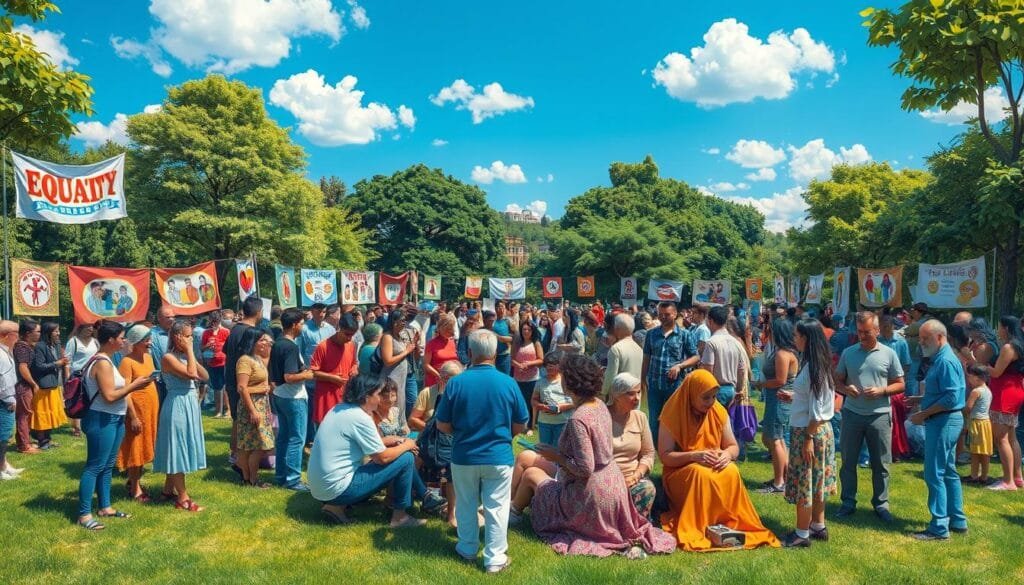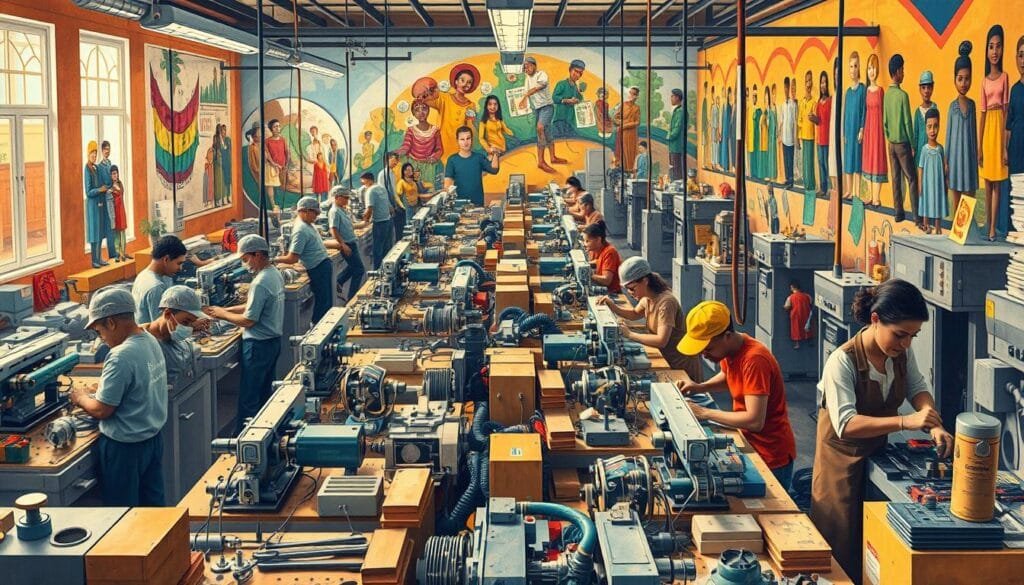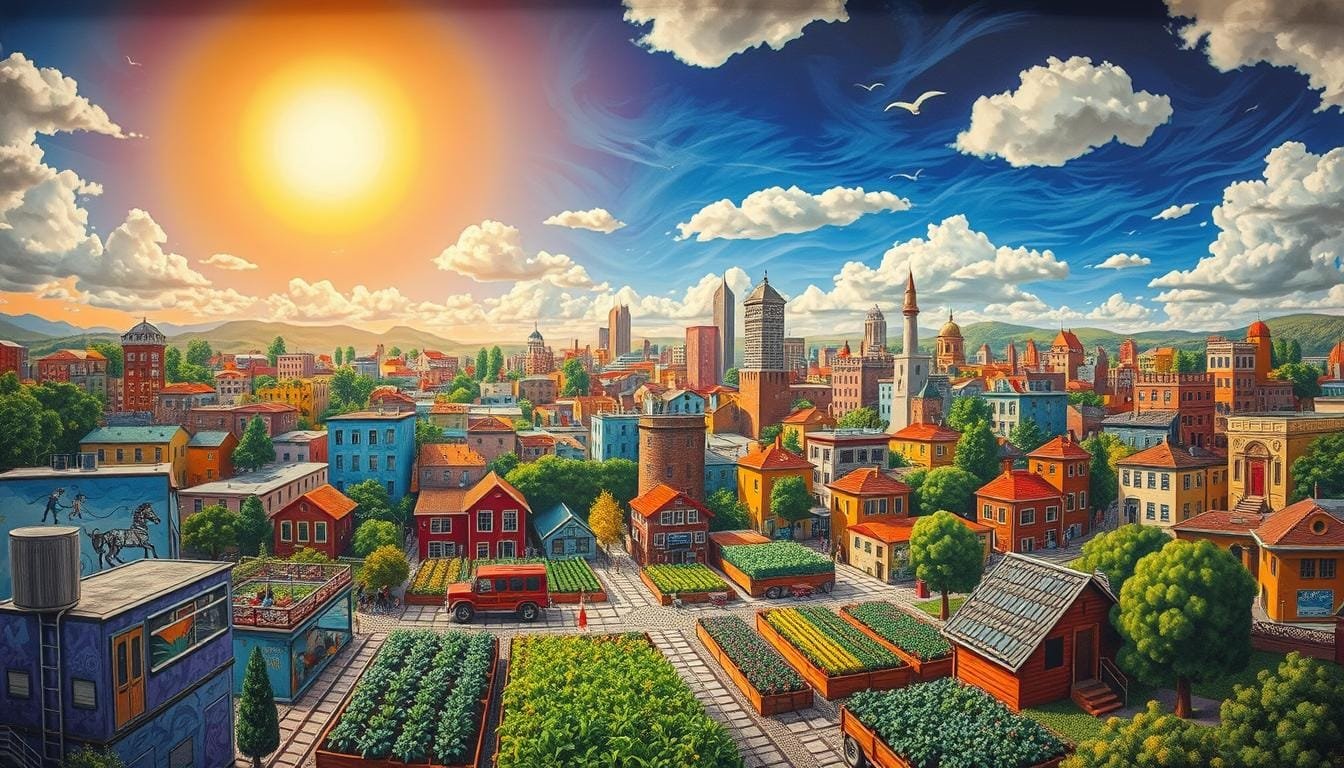Socialism has changed societies around the world, focusing on social welfare and changing economies. Since the early 20th century, its impact has been big and complicated. In the 1912 election, Eugene V. Debs got six percent of the vote. Socialists also held 1,200 positions in 340 cities. This showed socialism’s growing impact in America. Also, Sen. Bernie Sanders won 45 percent of the Democratic primary vote in 2016. This showed a new interest in socialist ideas in today’s politics.
A 2018 YouGov survey found that 35 percent of young adults under 30 like socialism. Also, 58 percent of them think socialism means social democracy, not just government control. This shows how people now see socialism. They link it to social equality and welfare in Western countries.
Now, socialism means social programs, spreading wealth, and fair policies. Many Western European countries use socialism to lower income gaps and make sure everyone has basic needs met. This includes things like social security, public schools, and healthcare. Socialism’s push for everyone’s well-being and fairness in the economy is clear.
Key Takeaways
- The societal impact of socialism includes increased social welfare and transformation of economic systems.
- Eugene V. Debs and Bernie Sanders illustrate significant historical and modern influences of socialism.
- Younger generations are increasingly viewing socialism favorably, associating it with social democracy.
- Western democracies incorporate socialist principles to reduce income inequality and ensure access to basic needs.
- Key elements of socialism are designed to promote collective well-being and economic justice.
Introduction to Socialism
Socialism sparks a lot of debates and discussion. To really get what socialism means for society, we have to look into what it is, its history, and main ideas. This journey will give us a complete picture of how socialist ideas have grown and worked around the world.
Defining Socialism
The idea of socialism is about all of us or the government owning and running the ways we make and share goods. It’s different from capitalism, where private people and companies own these processes. Socialism tries to stop wealth and power from piling up like they often do in capitalism. In a full-on socialist economy, everyone has a say and controls how things are produced. This helps to share out resources and chances fairly.
Historical Background
The story of socialism goes way back to old communal systems, but it really started to take shape in the 19th century. Socialist ideas popped up as a fix to the unfairness of the Industrial Revolution. A big moment was the 1917 Bolshevik Revolution in Russia, making socialist plans well-known. Yet, the end of communist governments in Eastern Europe and the Soviet Union’s fall in 1991 lessened socialism’s worldwide influence. Still, countries like China, Cuba, Laos, North Korea, and Vietnam keep weaving socialism into their ways of running things.
Basic Principles and Ideals
At its heart, socialist ideals fight for fair wealth sharing, safety nets, and the government managing key industries. This ensures everyone’s basic needs are covered. These ideas have created strong welfare and safety systems in many socialist places. Modern socialists lean towards systems with lots of rules and sharing, like democratic socialism or market socialism, instead of central planning. This shift can be seen in the social changes in Scandinavian countries. They have things like healthcare for everyone and free college.
| Country | System | Notable Features |
|---|---|---|
| China | Communist State | Maintains central planning alongside market reforms |
| Cuba | Communist State | Government control over most industries |
| Vietnam | Communist State | Mix of socialist and free-market policies |
| Scandinavian Countries | Democratic Socialism | Strong social safety nets and public services |
Impact on Economic Structures
Socialism has played a big role in changing how economies work. It pushes for resources to be shared more fairly. This means moving from private to public control.
Shift from Private to Public Ownership
Moving to public ownership is key in socialism. It wants to fix the unfairness seen with capitalism. By focusing on community needs instead of private gains, we see big changes.
These changes include taking over industries and sharing wealth more evenly. For example, the Russian Revolution in 1917 saw Vladimir Lenin stop private land ownership. He gave land to the peasants and changed how the economy was managed.
Economic Planning and Centralization
Central planning under socialism means the state guides the economy. This method aims at making resource sharing equal but has been critiqued for limiting freedom. For instance, the Soviet Union tried to grow industries fast with the Five Year Plan.
At first, it worked, and production went up. But by the 1970s, growth slowed down. This showed the limits of having everything centrally planned. During the 1980s, the Soviet Union tried to fix these problems with some reforms.
| Period | Policy | Outcome |
|---|---|---|
| 1917-1921 | War Communism | Severe decline in production |
| 1921-1928 | New Economic Policy (NEP) | Partial recovery |
| 1928-1940 | First Five Year Plan | Industrial growth, agricultural challenges |
| 1960s | Central planning continuation | High economic growth, but declining life expectancy |
| 1980s | Perestroika | Attempted reforms, economic stagnation |
In summary, moving to public ownership and central planning has really changed economies. Some attempts worked, others faced big hurdles. The goal was always to make things fairer for everyone.
How Did Socialism Changed Society
Socialism started as a bold idea in the mid-1800s. People like Karl Marx and Friedrich Engels led the way. Their Communist Manifesto in 1847-48 shared the goals of socialism. They dreamed of a society where everyone is equal.

Socialism has changed things in many places and times. For example, it played a big part in Europe during the Industrial Revolution. This shows how socialism grew and changed over 175 years, becoming a major movement.
The Soviet Union saw big changes because of socialism in the 20th century. They tried to get rid of class differences by controlling the economy and production. Even though they faced problems, socialism’s impact is undeniable.
In 1899, the Australian Labor Party did something huge in Queensland. They became the first elected socialist government. This showed how much socialism was starting to change the world towards fairness and public welfare.
China changed a lot under socialism after 1949. They made big moves like giving out land evenly and the Great Leap Forward. These steps were about fixing inequality between rural and city life.
The New Left came about in 1968, challenging both Soviet-style socialism and older social democracy. This time showed how people were thinking differently about what socialism means.
When the Soviet Union fell in 1991, it was a big moment. It made people talk more about socialism and its goals. This showed socialism’s journey wasn’t straight-forward.
The pink tide in Latin America in the 21st century brought socialism back into the spotlight. Leaders in places like Venezuela pushed for new ways to tackle poverty and inequality.
Today, people still talk a lot about what socialism can do. It’s all about making life fairer, fixing economies, and helping poor countries. Socialism’s effects on our world are deep and ongoing.
Effects on Social Equality
Socialism pushes for equality in nations across the globe. It uses shared ownership and policies that spread wealth to fight income gaps. The goal is to make sure wealth is fairly shared among everyone.

Reduction of Income Inequality
Socialism works to make income more equal. It uses taxes that increase with income to narrow the rich-poor divide. Marxism, part of socialist thought, criticizes how capitalism supports unfairness. It calls for big changes to fix this.
Countries with socialist policies have seen smaller income gaps. This shows socialism can help balance wealth.
Access to Basic Needs
Socialism ensures people can reach vital services like healthcare and schooling. These are seen as rights everyone should have. Countries like Sweden and Norway mix democracy and socialism to offer strong social support.
Role of Social Programs
Social safety nets are key in socialism. They make sure everyone has a basic quality of life. Movements like trade unions grew under socialism, fighting for workers and better lives. Read more about the role of socialism for deeper insight.
| Core Principles | Impact on Society |
|---|---|
| Equality | Strives to level economic playing fields by reducing income disparities |
| Social Welfare | Provides universal access to healthcare, education, and housing |
| Collective Ownership | Shifts resources from private hands to public domains for equitable distribution |
| Democratic Participation | Encourages active involvement of citizens in economic and political decisions |
In conclusion, socialism greatly impacts how fair and equal societies are. It does this through policies that distribute wealth and social programs that support everyone.
Transformation in Labor and Production
The way we work and produce goods under socialism is a big change from capitalism. It puts the community and working together first, not just making money. This means people work in teams and make things that help everyone.

Socialism changes how things are owned, moving from private to public hands. This can happen through different ways, like central or participatory planning. When private ownership ends, so does the traditional job market. This makes working for oneself legally tricky.
Social ownership means everyone has a say over assets and what’s made from them. There’s no need to work for someone else, since everyone owns a part of everything.
In a socialist system, everyone who can work does something useful for society. For instance, in the Soviet Union, the law required people to work hard for the good of all. This helped make sure everyone followed socialist work ideas.
Productivity changes too, but not because of personal profit. Innovation comes from working together and making plans as a community. This way of doing things can lead to fairer use of resources and less inequality.
| Capitalism | Socialism |
|---|---|
| Private Ownership | Social Ownership |
| Profit-Oriented Production | Societal Needs-Oriented Production |
| Wage Labor | Cooperative Management |
Overall, moving to socialism means completely changing how work and production are organized. It’s all about what’s best for everyone, showing the core values of socialism.
Comparative Analysis: Socialism vs. Capitalism
When we talk about socialism versus capitalism, it’s key to note that many countries use a mix of both. This mix affects society and the economy differently. The features of each system shape their outcomes in distinct ways.
Key Differences in Theory and Practice
Capitalism focuses on private control and making profits. On the other hand, socialism involves more government control or ownership. It aims for everyone to have an equal share of wealth and for the community to co-own big industries.
Capitalism became dominant in the late 19th century, driving growth but also leading to inequality. Socialism came up as an answer, inspired by Karl Marx in 1848. He saw capitalism as a system filled with class conflict.
Real-world Examples and Outcomes
In capitalist countries like the USA, a small group holds most of the wealth. But, socialist countries like China and Cuba have grown fast. China’s economy grew about 9% every year for many years, with the government owning key business sectors.
Case Studies
Looking at how socialist and capitalist countries are run offers interesting insights. Countries like Singapore have thrived under capitalism. They are seen as more innovative because they reward personal effort.
Socialist countries are known for distributing wealth more evenly. This leads to less difference in income between people. Sharing wealth more equally is a common feature in these countries.
Looking at specific examples helps understand socialism and capitalism better. Some capitalist countries, like the US, mix in socialist elements, like welfare programs. This mix shows how the two systems can blend.
In socialist nations like China, the government plays a big role in the economy. This includes running important business sectors. This way, the focus is on the good of everyone, not just making profits.
| Aspect | Capitalism | Socialism |
|---|---|---|
| Ownership | Private | Public/Governmental |
| Economic Emphasis | Profit-driven | Social Welfare |
| Wealth Distribution | Unequal | More Equal |
| Innovation and Efficiency | High | Moderate |
| Government Role | Limited (varies) | Extensive |
Ending our look at socialism versus capitalism, we gain insight into their effects on society and the economy. Understanding these systems shows us ways to build better governance and social structures.
The Role of Socialism in Modern Democracies
Modern socialism plays a complex part in democracies today. It has changed a lot from the past to now. Looking at history and what’s happening today, we can see how socialism in democracies has grown.
Today’s democracies mix in socialist ideas to tackle big challenges. Things like healthcare, education, and welfare come from socialist thinking. This mix helps everyone get what they need. It shows how socialist ideas work in real laws.
After 1953, the Soviet Union started to change. It moved away from the harsh rules of before. This time was about making things better and trying new ideas. It tried to blend socialist ideas with how a country is run.
The Soviet Union didn’t last forever, though. It ended after 74 years. This shows the good and bad of trying to run a country this way. It’s tough to make ideal plans work in a strict system. Today, we talk a lot about how to make socialism work in democracies.
Many talk about ‘state socialism’ these days. It means the government has a lot of power. Some think it’s too much, but others say it fits with democracy. It’s about making laws fair for everyone.
- How socialist ideas are in democracies.
- Changes after 1953 and why they matter.
- The current debates on socialism and how to make it work.
Looking closely, socialism and democracy both want the best for everyone. Democracies sometimes move slow because making big changes is hard. But socialists say we need strong actions to make things better. We keep talking about how to make socialist ideas work in democracies.
| Aspect | Socialist Policies | Democratic Governance |
|---|---|---|
| Healthcare | Socialized Healthcare | Public Health Systems |
| Education | Free Education | Public Schools |
| Social Welfare | Universal Basic Income | Welfare Programs |
| Policy Implementation | Bold Reforms | Practical Governance |
Looking at social issues through socialism in democracies helps. As we learn more about socialism today, we see we need smart plans. This is how we make life better for everyone.
Conclusion
As we conclude our study, let’s ponder the complex world of socialism and its deep effects on society. It draws from Karl Marx and Friedrich Engels’ ideas, aiming to fix the unfair wealth gap created during the Industrial Revolution. Marx dreamt of a world without class divides, where workers would rise above the wealthy. This idea is very different from capitalism, which focuses on private ownership.
In our journey through socialism’s landscape, we noted how it varies across countries. China and Cuba stick to a strict communist model, whereas Norway and Denmark mix capitalism with socialist policies. Interestingly, in the U.S., even though socialism isn’t a leading political force, programs like Medicare and Social Security share socialist values within a democracy.
Looking forward, socialism’s role in democracies is changing. In Europe and the U.S., democratic socialism promotes fairer wealth sharing and progressive changes. With growing economic inequality and its popularity among the youth, democratic socialism could be key in solving modern issues. Wrapping up, socialism’s adaptability and influence offer hopeful ways to improve fairness and collective well-being in the future.
FAQ
What is the societal impact of socialism?
Socialism aims for equality and shared benefits in society. It brings about social welfare programs and changes in economic systems. The goal is a society without classes, where resources go to everyone’s needs, not just the rich.
How does socialism influence economic structures?
Socialism changes economies by promoting public over private ownership. It seeks to stop private profit motives and share benefits equally. Resources are allocated by central planning to be more effective.
Can you define socialism?
Socialism means everyone owns production together. It fights against the wealth and power of capitalist systems. The aim is fair wealth sharing, safety nets, and government control over key industries.
What is the historical background of socialism?
Socialism grew from ancient communal practices and evolved during the Industrial Revolution. Today, forms like democratic socialism focus on fair resource distribution and welfare.
What are the basic principles and ideals of socialism?
Socialism’s core ideas are fair wealth sharing, social safety, and controlling key industries. It strives for a community-based resource sharing society.
How has socialism changed societies?
Socialism has lessened income gaps and boosted access to essential needs. It brought social programs ensuring a life standard for everyone, no matter their wealth.
What is the effect of socialism on income inequality?
Socialism reduces income inequality through redistributing policies and sharing wealth. It ensures wealth is shared through social programs and fair taxes.
How does socialism ensure access to basic needs?
In socialism, everyone has the right to basic needs like healthcare and education. Social programs help provide these rights to all citizens.
What role do social programs play in socialism?
Social programs are crucial in socialism. They provide safety and access to basics, helping everyone during tough economic times. They boost overall welfare.
How does socialism transform labor and production?
Socialism changes work and production to cooperative models. It aims to meet society’s needs instead of making private profits. This affects productivity, innovation, and worker happiness.
What are the key differences between socialism and capitalism?
Socialism and capitalism diverge in economic control and priorities. Socialism opts for public ownership and central plans. Capitalism chooses private ownership and free markets. Socialism focuses on welfare, capitalism on economic freedom.
Are there real-world examples and outcomes of socialism?
Examples of socialism include the Soviet Union and modern democratic nations like Sweden. These cases show both successes and failures in applying socialist ideas.
How is socialism represented in case studies?
Socialism case studies reveal its real-world application. They explore impacts on economies, equality, and policy-making.
What role does socialism play in modern democracies?
Modern democracies integrate socialism to reduce inequality through social programs and policies. The challenge lies in blending socialist and capitalist elements.
